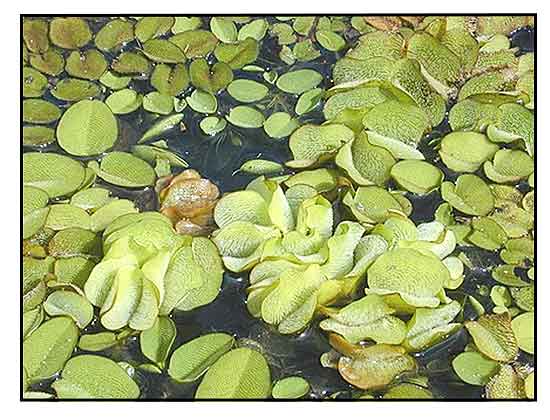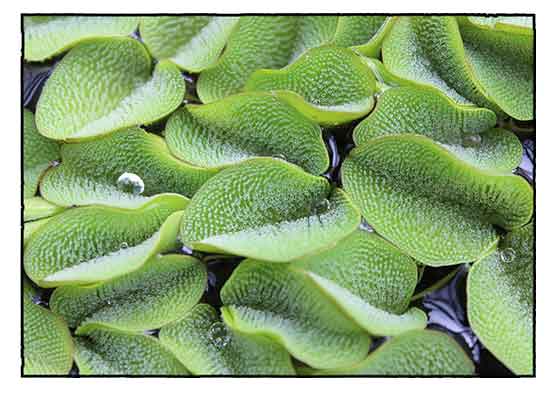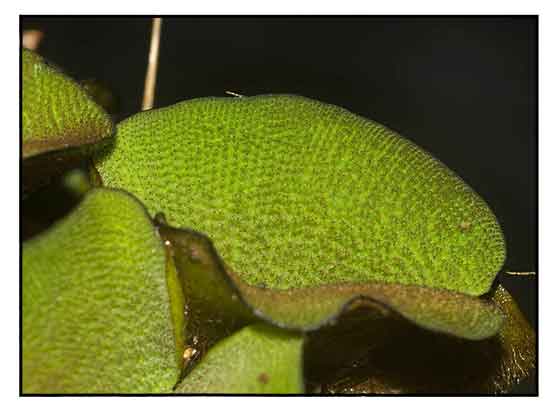 Gen info Gen info
- Salvinia molesta has been reported as occasionally escaping from cultivation in Taiwan. It is a very aggressive weed of hybrid origin that has been declared a noxious weed and banned from cultivation in many countries. Biological control using a weevil has been successful in some areas (R. C. Moran, Fiddlehead Forum 19: 26-28. 1992).
Botany
Floating fronds: lamina oblong to obovate or orbicular, ca. 2.5 × 2.4-3 cm, base rounded or cordate, apex emarginate, flat or often infolded along costa, surface abaxially with sparse pale multicellular hairs, adaxially densely papillate, papillae cylindrical, ca. 1.5(-2) mm, terminated by (2-)4 setae incurved and joined at their tips; submersed frond to 12 cm. Sporocarps in long chains of up to 55, ca. 1 mm in diam., microsporangia up to 53, megasporangia 2(or 3), more densely hairy; most sporangia empty, spores if present deformed. (Flora of China)
Distribution
- Introduced.
- Naturalized.
- Native to Argentina and Brazil.
- Grown as an aquarium plant, now widely naturalized and invasive.
- Declared a noxious weed in many countries and banned from cultivation.
 Invasiveness Invasiveness
- Salvinia molesta is one of the most serious plant management problems in the world. It reduces the concentration of nutrients and oxygen, raises CO2 and hydrogen sulfide concentrations of water leading to decreased water quality.
(6)
-
In nutrient rich waters it may reach a density of 30,000 small plants per m2 and can double its biomass in 2 days. (3)
- Dense mats of giant salvinia interfere with rice cultivation, clog fishing nets,
disrupt water access for humans and livestock, wildlife, recreation, transportation, irrigation, hydroelectric generation, and flood control. (6)
- Infestation can reach up to 400 tonnes of wet weight per hectare.
(9)
- Failed attempts at control by chemical and mechanical method may lead to environmental consequences by introduction of chemicals and bioagents into the ecosystem.
 Constituents Constituents
- Phytochemical screening of leaf extracts yielded alkaloids, tannins, and saponins in significantly high ranges. Total phenolic content was 9.84 mg GA equivalents/g and total flavonoid contents was 10.89 mg quercetin equivalentw (QE)/g. (see study below) (4)
- GC-MS analysis of ethanol leaf extract
revealed the presence of bioactive components such as apiol, hexadecanoic acid, pentadecanoic acid and octadecatriene etc. (see study below) (5)
- Phytochemical analysis yielded carbohydrates, proteins, tannin, carotenoids, alkaloids, flavonoids, terpenoids, saponin, and phenol. (6)
- Study for fresh water fern isolated
two glycosides, 6'-O-(3,4-dihydroxy benzoyl)-beta-D-glucopyranosyl ester (1), and 4-O-beta-d-glucopyranoside-3-hydroxy methyl benzoate (2), along with five known compounds methyl benzoate (3), hypogallic acid (4), caffeic acid (5), paeoniflorin (6) and pikuroside (7). (7)
- Study of aqueous methanol extract isolated one new glucopyranose derivative 6'-O-(3,4-dihydroxybenzoyl)-4'-O-(4-hydroxybenzoyl)-α/β-D-glucopyranoside (1) and four known glycosides. (see study below) (8)
- Column chromatography of active fractions of fern extract for phenolic compounds yielded ascorbic acid, quercetin, gallic acid, resorcinol, catechol, vanillin, and benzoic acid. (see study below) (9)
- Crude protein content of S. molesta is relatively high in all stages of growth (32.2% young, 37.5% medium, and 36.8% mature) compared to terrestial forages. Lignin content is high as 13.7%, average crude ash 17.3%, and crude fiber 35r.2%, while tannin content increased as the plant matures (Moozhiyil and Pallauf). (9)
- Bioactive-guided fractionation of ethanol extract isolated 50 compounds. Of the six new compounds (1-6), salvinio (1) and salviniside I (2) and salviniside II (3) are novel benzofuran glucose conjugates. (see study below) (10)
- Quantitative analysis of S. molesta extract yielded phenol 7.803, flavonoid 121.41, tannin 46.154, saponin 13.12, alkaloid 1.74. (see study below)
Properties
- Invasiveness.
- Studies have suggest antibacterial, antioxidant, urease inhibitory, phytoremediative, cytotoxicity, antitumor, immunomodulatory properties.
Parts used
Leaves.
Uses
Folkloric
- No reported folkloric medicinal use in the Philippines.
Others
- Potential uses: Floating aquatic weeds have been used for mulch, compost, fodder, paper making, handicrafts, and bio-gas generation. An impediment to commercial use is salvinia's high water content, up to 90%. (3)
- Phytoremediation: Species has phytoremediation potential because it accumulates chromium, and absorbs nitrogen and phosphorus.
Studies
• Antioxidant / Leaves: Study evaluated the antioxidant activity of leaf extracts of Salvinia molesta. Among the solvent extracts, the ethanol extract showed maximum antioxidant activity by DPPH assay (90.3%). (see constituents above) (4)
• Antibacterial / Leaves: Study evaluated the antibacterial activity of various leaf extracts against selected pathogens viz., Pseudomonas aeruginosa, Aeromonas hydrophila, Escherichia coli, Bacillus cereus, B. subtilis, and Staphylococcus aureus. The ethanolic extract showed highest activity against Pseudomonas aeruginosa followed by Aeromonas hydrophila. (see constituents above) (5)
• Antioxidant / Urease Inhibitory Activity: Study of aqueous methanol extract isolated one new glucopyranose derivative 6'-O-(3,4-dihydroxybenzoyl)-4'-O-(4-hydroxybenzoyl)-α/β-D-glucopyranoside (1) and four known glycosides were identified. Compound 1 exhibited promising antioxidant potential with IC50 of 48.2, 60.3, 42.1 µM against DPPH, superoxide radical, and oxygen burst, respectively. Jack bean urease inhibition assay showed IC50 of 99.1 µM. Compound 1 is a mixed-type inhibitor of urease with a Ki value of 91.8 µM. Results suggested further studies through animal models for its potential against oxidative stress phosphodiesterase-II and urease-induced pathologies. (8)
• Phenolic Compounds / Natural Antioxidants: Column chromatography of active fractions of fern extract for phenolic compounds yielded ascorbic acid, quercetin, gallic acid, resorcinol, catechol, vanillin, and benzoic acid. Study suggests
the plant is a potential source of natural antioxidants that can be used as lead candidate for synthesis of antioxidant drugs for use in the treatment of many oxidative stress related diseases. (9)
• Cytotoxicity Against Human Tumor Cells: Bioactive-guided fractionation of ethanol extract isolated 50 compounds. Of the six new compounds (1-6), salvinio (1) and salviniside I (2) and salviniside II (3) are novel benzofuran glucose conjugates. Sixteen abietane diterpenes (1, 7-17, and 19-22) exhibited invitro activities against human tumor cells and 7 and 8 showed selective cytotoxicity to tumor cells over normal cells. (10)
• Immunomodulatory: Study evaluated the immunomodulatory efficacy of S. molesta ethanol leaf extracts in P. aeruginosa challenged freshwater crab, Oziotelphusa senex senex. Both male and female infected crab groups showed significant increase in LPO while extract treated group showed a decrease in LPO levels. Results suggest remarkable pharmacological and therapeutic effects and can act as a potent immunomodulatory agent. (11)
• Silver Nanoparticles / Antibacterial / Leaves: Study reports on the economic, ecofriendly, and simple green route for rapid biosynthesis of silver nanoparticles using aqueous leaf extract as bioreductant and stabilizing agent. The synthesized AgNPs were showed antibacterial efficacy against both Gram positive and Gram negative bacteria. (12)
• Phytoremediation of Wastewater / Review: Among aquatic plants, Salvinia molesta and Pistia stratiotes have been widely use for the treatment of agricultural, domestic and industrial wastewater. The wide application of these plants is due to availability, resilience in toxic environment, bioaccumulation potentials, invasive mechanism and biomass potentials. Both possess high amounts of biomass compounds making them suitable candidates for bioenergy generation.Studies are suggested for remediation of radioactive, nanoparticle, pahrmaceutical, and polymer base wastewater. (13)
• Phytoremediation of Cirpofloxacin Contaminated Water: Study evaluated the toxicological safety of ciprofloxacin-contaminated water treated with Salvinia molesta for 96h. Neotropical catfish Rhamdia quelen was used as model for potential of mitigating drug accumulation in fishes. Fish exposed to Cipro (1 and 10 µg.L) in untreated water showed toxic responses with alterations in hematological, biochemical, histopathological biomarkers and accumulation of Cipro in muscles at high concentrations high for human consumption (target quotient >1). Fish exposed to water treated with S. molesta showed no toxic effect and no accumulation of Cipro in their tissues. S. molesta removed up to 97% of Cipro from the water. The decrease of Cipro from water prevented to toxic effects of Cipro on R. quelen fish and prevented antimicrobial accumulation in fish flesh. Study showed potential of phytoremediation as an efficient nature-based solution to prevent environmental toxicological effects of antimicrobials to nontarget organisms such as fish and humans, and also helps combat antimicrobial resistance. (14)
• Potential Air-Retaining Ability and Thermal Insulating Effect for Fabrics Inspired by S. molesta:
The plant leaf of S. molesta can retain an air layer underwater due to the hydrophobic and elastic eggbeater-shaped hairs on its surface, which have potential applications in thermal insulation devices. Air volume change and thermal insulation tests showed that terry fabrics (F1 and F3) can retain an air layer on their surfaces and hold air in between the fibers and inside the loops underwater for a long time, providing both thermal insulation and buoyancy force – the two key features of life-saving appliances. (15)
• Phytoremediation of Arsenite Contaminated Water / Role of Antioxidant Enzymes: Study tested the hypothesis that S. molesta counteracts the harmful arsenite (ASIII) effects by activating scavenging reactive oxygen species (ROS) enzymes. Study evaluated the role of superoxide dismutase (SOD), catalase (CAT), peroxidase (POX) and ascorbate peroxidase (APX) in S. molesta tolerance to arsenite and its used in the remediation of contaminated water. Results showed S. molesta presents enzymatic antioxidant defenses to alleviate arsenite toxicity and are more effective in floating leaves. Additional studies exposing plants to more prolonged stress using arsenite concentrations closer to those found in contaminated environments. (16)
• Cosmeceutical Solid Soap Potential: Study evaluated the potential of this invasive species as a cosmeceutical soap product and analyzed quality, safety, and acceptance. The pH was 10.68 and moisture content of S. molesta soap was 20.01 (standard commercial soap 10.53 and 9.05 respectively). Foam height was higher. The values of S. molesta soap extracts attributes were within the limits set by standard quality of soap. The presence of S. molesta extracts in solid soap provides antibacterial potential with excellent ability to clean and disinfect skin. Results suggest an alternative to tackling the invasive issues of the species. (17)
Availability
Wild-crafted. |

![]()






